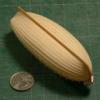-
Posts
13,131 -
Joined
-
Last visited
Content Type
Profiles
Forums
Gallery
Events
Everything posted by druxey
-

Attaching Pedestals
druxey replied to kier's topic in Discussion for a Ship's Deck Furniture, Guns, boats and other Fittings
The earlier you consider and make the arrangements for the pedestals, the easier it is. -

Fender Guitar by Dan Vadas - FINISHED - CARD
druxey replied to Dan Vadas's topic in Non-ship/categorised builds
So, next you'll be designing paper models!!! -

HMS Enterprise by AlexBaranov - 1:36
druxey replied to AlexBaranov's topic in - Build logs for subjects built 1751 - 1800
Nice start! -

Original Rigging for Cutters of 1763: with a Jib boom?
druxey replied to Gregor's topic in Masting, rigging and sails
For a start, the figures you you read as '0' are in fact the old script way of writing '8'. It appears sort of sideways on. Hence, not 22 10, but 22 18, etc. A yard is 3' 0", so 22 18 translates as 67' 6". 'Excl' is, as you say, excluding. I believe that the length of the mast head included the tenon, (but not the tenon at the heel of the mast) but need to check that. One needs to dig a bit to answer the other questions you have. Normally poles are integral to topmasts in lieu of a topgallant mast, or (as in your illustration) is the extension to the topgallant mast, but not to lower masts. The exception might be a one-piece mast. It is possible that this is what was intended. If that were the case, the mast is a single stick, perhaps the part above the stops being called a topgallant rather than a topmast. Does any of this help? -
That seems to be your answer, although I like the typically French comment; "It should be noted that these could equally be used to hoist barrels of wine.”
- 263 replies
-
- nave tonda
- round ship
-
(and 2 more)
Tagged with:
-
The nearest carriage I can find is in Caruana, Volume II on page 208. It has a two-part trucked (wheeled) carriage. All four trucks are 6" in diameter. The lower part, 4' 0" long, is wedge shaped, higher at the aft end. The upper part, also wedge shaped but with the narrow end aft, can slide up this inclined plane. This part has conventional steps. The illustration shows a 24 lb carronade mounted. This non-recoil carriage was invented by the same Captain Schank that invented the sliding keel.
-
I'm sorry to read of your situation, Mark. I hope that things will improve for you sooner rather than later. In the meantime, my best wishes to you.
-
Dowmer: actually many contemporary models show the figure with head turned to starboard to a greater or lesser degree (lions excepted). It's later half-length ones that look straight ahead. So the casting resembles the original model quite closely, except that the head there is tilted as well as turned.
- 1,784 replies
-
- winchelsea
- Syren Ship Model Company
-
(and 1 more)
Tagged with:
-
It is very doubtful that Victory of 1765 had brass ordnance. The previous Victory of 1737 certainly did - she was fully armed with brass - but all that was lost when she went down. (Perhaps this has created the confusion, with two ships of the same name?) Very few guns have been salvaged: most are on the sea bed. The cost of brass vs iron was considerable, and the government was not about to sink large amounts into more brass!
-
I agree with Y.T. Paint the paper or card to match the wood color.
About us
Modelshipworld - Advancing Ship Modeling through Research
SSL Secured
Your security is important for us so this Website is SSL-Secured
NRG Mailing Address
Nautical Research Guild
237 South Lincoln Street
Westmont IL, 60559-1917
Model Ship World ® and the MSW logo are Registered Trademarks, and belong to the Nautical Research Guild (United States Patent and Trademark Office: No. 6,929,264 & No. 6,929,274, registered Dec. 20, 2022)
Helpful Links
About the NRG
If you enjoy building ship models that are historically accurate as well as beautiful, then The Nautical Research Guild (NRG) is just right for you.
The Guild is a non-profit educational organization whose mission is to “Advance Ship Modeling Through Research”. We provide support to our members in their efforts to raise the quality of their model ships.
The Nautical Research Guild has published our world-renowned quarterly magazine, The Nautical Research Journal, since 1955. The pages of the Journal are full of articles by accomplished ship modelers who show you how they create those exquisite details on their models, and by maritime historians who show you the correct details to build. The Journal is available in both print and digital editions. Go to the NRG web site (www.thenrg.org) to download a complimentary digital copy of the Journal. The NRG also publishes plan sets, books and compilations of back issues of the Journal and the former Ships in Scale and Model Ship Builder magazines.


